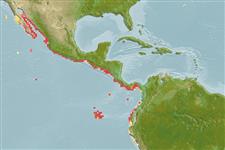Environment: milieu / climate zone / depth range / distribution range
Ökologie
seewasser riff-verbunden; tiefenbereich 0 - 18 m (Ref. 5227). Tropical; 30°N - 10°S, 120°W - 70°W
Eastern Pacific: Bahía Sebastían Vizcaino and the northern Gulf of California (Isla Angel de la Guarda and Puerto Lobos) to Peru, including the Galapagos Islands (Ref. 5590).
Size / Gewicht / Alter
Maturity: Lm ? range ? - ? cm
Max length : 18.0 cm SL Männchen/unbestimmt; (Ref. 28023); common length : 12.0 cm TL Männchen/unbestimmt; (Ref. 55763)
Kurzbeschreibung
Morphologie | Morphometrie
Body cylindrical; head with cirri above the eyes, on the nape, and at the posterior edge of the anterior nostril; maxillary not protrusible; each jaw with one row of incisiform teeth; anal and dorsal fins elongated ; lateral line divided into two, independent, overlapping segments (Ref. 55763).
Adults prefer the surge zone of unprotected rocky headlands with steep slopes. They wedge themselves in crevices close to shore in shallow water, darting out to defend their territory. Diurnal feeders that graze on algae and sessile invertebrates, using their comb-like incisor teeth to scrape food (Ref. 28023). Oviparous. Eggs are demersal and adhesive (Ref. 205), and are attached to the substrate via a filamentous, adhesive pad or pedestal (Ref. 94114). Larvae are planktonic, often found in shallow, coastal waters (Ref. 94114).
Life cycle and mating behavior
Geschlechtsreife | Fortpflanzung | Ablaichen | Eier | Fecundity | Larven
Oviparous, distinct pairing (Ref. 205).
Thomson, D.A., 1987. Reef fishes of the Sea of Cortez. The rocky-shore fishes of the Gulf of California. The University of Arizona Press, Tucson. 302 p. (Ref. 5592)
IUCN Rote Liste Status (Ref. 130435)
Bedrohung für Menschen
Harmless
Nutzung durch Menschen
Fischereien: nicht kommerziell; Aquarium: Kommerziell
Mehr Information
ReferenzenAquakulturAquakultur ProfilZuchtlinienGenetikElectrophoresesVererbbarkeitKrankheitenVerarbeitungNutrientsMass conversion
PartnerBilderStamps, Coins Misc.LauteCiguateraGeschwindigkeitSchwimmstilKiemenoberflächeOtolithsGehirngrößeSehfähigkeit
Tools
Zusatzinformationen
Download XML
Internet Quellen
Estimates based on models
Preferred temperature (Ref.
123201): 20.3 - 29.1, mean 26.1 °C (based on 200 cells).
Phylogenetic diversity index (Ref.
82804): PD
50 = 0.5312 [Uniqueness, from 0.5 = low to 2.0 = high].
Bayesian length-weight: a=0.00955 (0.00505 - 0.01805), b=2.99 (2.83 - 3.15), in cm total length, based on LWR estimates for this species & (Sub)family-body (Ref.
93245).
Trophic level (Ref.
69278): 2.7 ±0.25 se; based on food items.
Widerstandsfähigkeit (Ref.
120179): mittel, Verdopplung der Population dauert 1,4 - 4,4 Jahre. (Assuming tm=1 and Fec 100-1000).
Fishing Vulnerability (Ref.
59153): Low vulnerability (12 of 100).
Nutrients (Ref.
124155): Calcium = 82.9 [47.2, 125.0] mg/100g; Iron = 0.688 [0.441, 1.054] mg/100g; Protein = 18.7 [17.6, 19.6] %; Omega3 = 0.129 [0.087, 0.193] g/100g; Selenium = 22.1 [13.5, 38.2] μg/100g; VitaminA = 120 [41, 341] μg/100g; Zinc = 1.82 [1.31, 2.45] mg/100g (wet weight);
